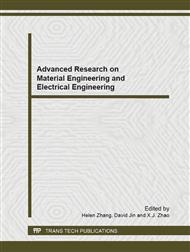p.186
p.193
p.199
p.204
p.209
p.213
p.218
p.222
p.227
Study of the Electricity-Draw Control System in Electrical Engineering Based on Neural Network DTC
Abstract:
In the electricity draws control system, the change of Low-velocity area of Rs will bring about a series of problem, especially the stator current and flux, will cause the distortion of the speed pulse vibration. The test discussed control scheme and optimization designs of asynchronous draw motors from exchange transmission electric locomotive operation characteristic demand. It adopts control strategy of neural network direct torque control (DTC) to control electricity draw the locomotive, to analyze the reacting of starting and sudden change of load, verifying this method may effectively improve the dynamic performance of the asynchronous motor, got up the very good inhibitory action to the low speed area torque pulsation. Thus the simulation results have proven the neural network DTC control strategy feasibility.
Info:
Periodical:
Pages:
209-212
Citation:
Online since:
March 2013
Authors:
Price:
Сopyright:
© 2013 Trans Tech Publications Ltd. All Rights Reserved
Share:
Citation:


